Sorafenib targets dysregulated Rho kinase expression and portal hypertension in rats with secondary biliary cirrhosis
- PMID: 19338580
- PMCID: PMC2697813
- DOI: 10.1111/j.1476-5381.2009.00158.x
Sorafenib targets dysregulated Rho kinase expression and portal hypertension in rats with secondary biliary cirrhosis
Abstract
Background and purpose: Extrahepatic vasodilation and increased intrahepatic vascular resistance represent attractive targets for the medical treatment of portal hypertension in liver cirrhosis. In both dysfunctions, dysregulation of the contraction-mediating Rho kinase plays an important role as it contributes to altered vasoconstrictor responsiveness. However, the mechanisms of vascular Rho kinase dysregulation in cirrhosis are insufficiently understood. They possibly involve mitogen-activated protein kinase/extracellular signal-regulated kinase (ERK)-dependent mechanisms in extrahepatic vessels. As the multikinase inhibitor sorafenib inhibits ERK, we tested the effect of sorafenib on haemodynamics and dysregulated vascular Rho kinase in rats with secondary biliary cirrhosis.
Experimental approach: Secondary biliary cirrhosis was induced by bile duct ligation (BDL). Sorafenib was given orally for 1 week (60 mg.kg(-1).d(-1)). Messenger RNA levels were determined by quantitative real time polymerase chain reaction, protein expressions and protein phosphorylation by Western blot analysis. Aortic contractility was studied by myographic measurements, and intrahepatic vasoregulation by using livers perfused in situ. In vivo, haemodynamic parameters were assessed invasively in combination with coloured microspheres.
Key results: In BDL rats, treatment with sorafenib decreased portal pressure, paralleled by decreases in hepatic Rho kinase expression and Rho kinase-mediated intrahepatic vascular resistance. In aortas from BDL rats, sorafenib caused up-regulation of Rho kinase and an improvement of aortic contractility. By contrast, mesenteric Rho kinase remained unaffected by sorafenib.
Conclusions and implications: Intrahepatic dysregulation of vascular Rho kinase expression is controlled by sorafenib-sensitive mechanisms in rats with secondary biliary cirrhosis. Thus, sorafenib reduced portal pressure without affecting systemic blood pressure.
Figures
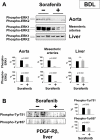
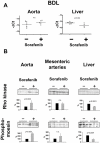
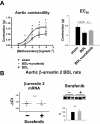
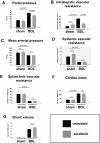
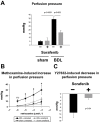


References
-
- Abou-Alfa GK, Schwartz L, Ricci S, Amadori D, Santoro A, Figer A, et al. Phase II study of sorafenib in patients with advanced hepatocellular carcinoma. J Clin Oncol. 2006;24:4293–4300. - PubMed
-
- Adnane L, Trail PA, Taylor I, Wilhelm SM. Sorafenib (Bay 43-9006, Nexavar®), a dual-action inhibitor that targets RAF/MEK/ERK pathway in tumor cells and tyrosine kinases VEGFR/PDGFR in tumor vasculature. Methods Enzymol. 2006;407:597–612. - PubMed
-
- Anegawa G, Kawanaka H, Yoshida D, Konishi K, Yamaguchi S, Kinjo N, et al. Defective endothelial nitric oxide synthase signaling is mediated by Rho-kinase activation in rats with secondary biliary cirrhosis. Hepatology. 2008;47:1–12. - PubMed
-
- Borkham-Kamphorst E, Kovalenko E, van Roeyen CR, Gassler N, Bomble M, Ostendorf T, et al. Platelet-derived growth factor isoform expression in carbon tetrachloride-induced liver injury. Lab Invest. 2008;88:1090–1100. - PubMed
Publication types
MeSH terms
Substances
LinkOut - more resources
Full Text Sources
Research Materials
Miscellaneous

